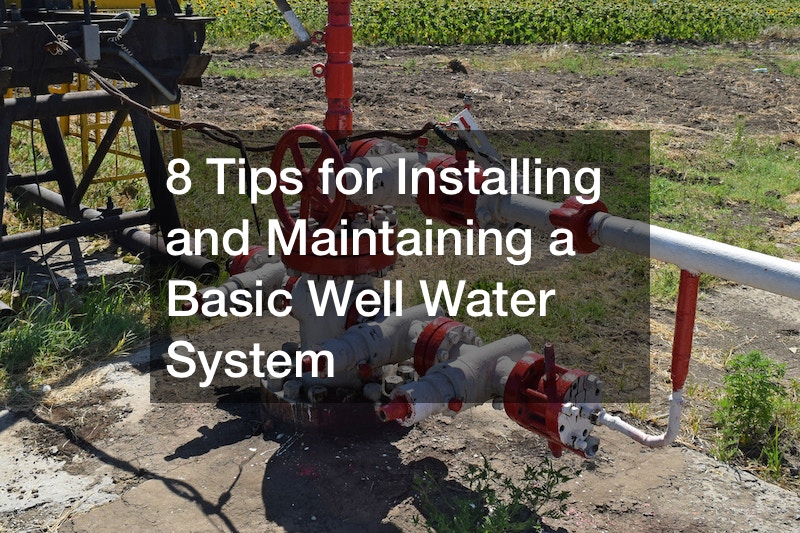8 Tips for Installing and Maintaining a Basic Well Water System


Basically, the purpose of a well system is to access groundwater and pump it into the home. This water can then be used to shower, wash dishes, drink, and do other things. For you to have a sufficient supply of water for your needs and to ensure that the water is free of contaminants, you need to work with reputable installers. You also need to have a strict maintenance schedule so that the well stays functional. While you can dig a well with your hands, as our ancestors did, most modern wells are installed using drills and other complex machines. Once drilled, the hole is lined using a casing to prevent it from collapsing. An electric pump is then placed in the well to deliver water to the home. Here are some tips for installing and maintaining your basic well water system.
Plan for Your Water Supply
Before you start thinking about anything else, you need to first plan your water supply. Having a beautiful house without an adequate water supply will not mean much. If you want to be comfortable and happy, you should ensure that you not only have enough water, but the water should be of good quality too. This means you need to ask yourself if you can even develop an adequate groundwater supply on the property. If not, you will need to look into other alternatives. Fortunately, most areas have enough groundwater supply. This means the only thing you may need to calculate is how much water you need.
People generally use different amounts of water depending on the time of day. A day’s use will likely be concentrated into periods of one or two hours. For instance, you may use lots of water during laundry time, when doing dishes, or in the bathroom. Your water supply must be able to meet the demands of your household at these peak times. Generally, your home will likely need about 150-300 gallons daily if there are less than four people staying together. You should also pay attention to things like landscaping. However, for that, you can look into other alternatives like rainwater collection.
Figure Out the Cost of Well Installation

Cost is a very important factor to consider whenever you are dealing with service providers. When it comes to well installation, you need to have a good idea of all the costs involved so you can budget accordingly. In most instances, installers price wells on a per-foot basis. The prices range from $24-30 dollars per foot. Please keep in mind that this is for drilling only. Experienced well installers should be able to give you clear estimates based on average depths. If they have worked on lots of wells in your locality, then they probably know how much you will likely part with depending on how much other people paid. After all, the costs shouldn’t differ much if they are compared with areas that have similar geologic features.
Apart from the drilling costs, you will also need to factor in the cost of the pump. This usually varies based on the size and type you are looking to purchase. For instance, most people get jet pumps for their basic well water systems. These cost about $1,500 on average. On the other hand, ‘submersible’ pumps go for around $3,000. The well installer should be able to explain what type of pump you need for your well and why. You may also encounter additional costs for labor and other materials depending on the specific needs of your site.
Choose Where to Dig the Well
The first thing you need to do if you plan to construct a well is to choose where it will go. According to the National Groundwater Association (NGWA), you should select your well site before you choose where to build your home. After all, there’s nothing more important than the quality of your drinking water. By now, you are probably thinking about how complicated it must be to choose the right site for your well and what factors influence your choice. Fortunately, you don’t have to burden yourself with all these choices. You can simply hire a licensed professional to make the site selection.
The NGWA keeps a database of all licensed professionals who can help you with choosing a location for your basic well water system. If you are lucky and you find someone who has worked in your area for a long time, chances are they already know what the water table is like and all the other well requirements. It’s important to discuss your household’s water usage with the well installer as you are choosing the site.
The well installer is supposed to take care of all the regulatory and legal documents and requirements. Depending on your state, you may need permits and fees, and there may be inspections involved. The local health department might also need to check out your site. All this can affect your overall budget.
Things to Consider When Choosing Location

Apart from the water table, there are other things that come into play when it comes to choosing the location of your basic well water system. For instance, you should consider nearby properties. Drilling companies will generally advise you if you don’t have any appropriate spots on your property. If this is the case, you must not force things. After all, you don’t really need to restrict your search to your property only. You can even install your well on your neighbor’s property. However, for this to happen, you should first talk to your neighbor and find out if they are willing to let you install a well on their property. Some neighbors can let you do this if you properly explain your situation. You can even offer financial compensation to sweeten the deal on their side.
If your neighbor agrees to let you install the basic well water system on their property, you will need to ensure that you get the permission in writing. This will provide you with proof that you were allowed to drill a well on their land. You also need to have them put a right of way to their well in writing. Again, this ensures that you can gain access to the well for things like repairs and servicing even though the well is on their land.
Don’t Install Your Well Too Close to a Septic Drainage Field
When installing a well, you should ensure that there are no septic drainage fields nearby. You don’t want to end up with water that’s contaminated by fecal matter. If fecal matter reaches your mouth, you can fall very ill and even die, which is what will happen if your well is situated close to a drainage field. While soil generally filters out bacteria, water needs to flow a specific distance through the soil for the bacteria to be eliminated. As long as your position you’re well outside this distance, you won’t have any problems with contaminated water.
There are several factors that affect the distance that should be between your basic well water system and the drainage field. For instance, you should consider how far above the water table the septic drainage field is. Apart from that, you must also consider the direction of flow of the groundwater. Different soils filter water differently. As such, soil type should be considered as well. When you hire a well drilling company, they should be able to figure out how far your well needs to be from the septic drainage field. This is calculated based on the factors mentioned above.
Keep the Well Away From Animal Pens
Do you have animal pens on your property? If yes, you should keep your well away from the pens. When you have multiple animals leaving their droppings in a confined space, there will be a high concentration of bacteria in that space. If you situate your well too close to the pens, you can end up having water that is contaminated by bacteria from the pen.
Avoid Rocky Areas
The last thing to consider is the presence of large rocks. You must avoid placing your basic well water system where there are huge rocks in the ground. If you notice lots of large rocks on the surface, chances are there are large rocks below the ground as well. These rocks will make it very difficult for your well installation company to drill the well. They may even charge you more money because of that. Instead, you should choose a location that doesn’t have any rocks at all. That makes it very easy to dig the well. Of course, small stones and pebbles will not present a huge challenge. These can be picked and thrown away easily. As such, they don’t particularly pose any serious threat to the drilling equipment. Again, your well installer should take this into consideration when figuring out where to place the well on your property.
Clear the Land Before Installation
Once you have chosen a spot to install your basic well water system, there are certain things you can do to make the work easier for the well installation company. One of the most important things to do is clear the land. If there are any trees on the spot you want to install your well, you need to get rid of them as soon as possible. All you need to do is to find a tree removal company to do this job for you. This will make the water well drilling process much easier. Water well installation makes use of large pieces of equipment, therefore, it can be difficult to get the equipment to your site if there are trees in the way. A tree removal specialist will help you get rid of trees so that the well construction equipment can be moved easily.
Find a Reputable Installer

Once the land is cleared and the site is ready, the next step will be to find a well installation company to work with. If you know anyone who has recently installed a well, you can find out if they know any good well-installation companies. Apart from that, you can do your own search on the internet to find any local well drilling companies. There are several things to consider when looking for a well water installation specialist. Like any other service provider, you can check references for a well-drilling company. This will enable you to see what other people think about the quality of services provided by that company. You should never hire an equipment specialist without checking reviews first. Once you trim your list to a few companies, you can ask a few questions to find out which drilling company would best suit your needs. For instance, you ask things like which well pumps would work best on your property. You should also find out about the experience, licensing, and insurance. The answers to these questions will help you to make a better decision.
Make Some Ancillary Upgrades
When you install your basic well water system, you need to take this opportunity to also make some ancillary upgrades in your home. You should think about how best to save water and energy. For instance, you can do away with your storage tank water heater and look into some tankless water heaters. These save energy and they ensure you have enough hot water at any point. You should also consider having a water tank for storage. All you need is a plastic tank and a few building supplies and you can be guaranteed that even if your well pump malfunctions for a few hours, you will still have water on your property.
Prepare for Repairs

Water wells have several pieces of equipment that can fail. As such, you should always be ready to buy some equipment replacement parts. If you are handy, and always excited about DIY repairs, you may also need to buy some machine tools for repairs. However, it’s generally advisable to let the professionals handle your well repairs.
Installing a basic well water system on your property is a good move. This will help you ensure that you have clean water in your home at all times. However, for the best results, you need to take your time to figure out where to place the well and who to work with. Finding a reputable well installer should not be too difficult. As long as you don’t rush the vetting process, you should get a licensed, insured, and experienced well-drilling contractor to work with.


